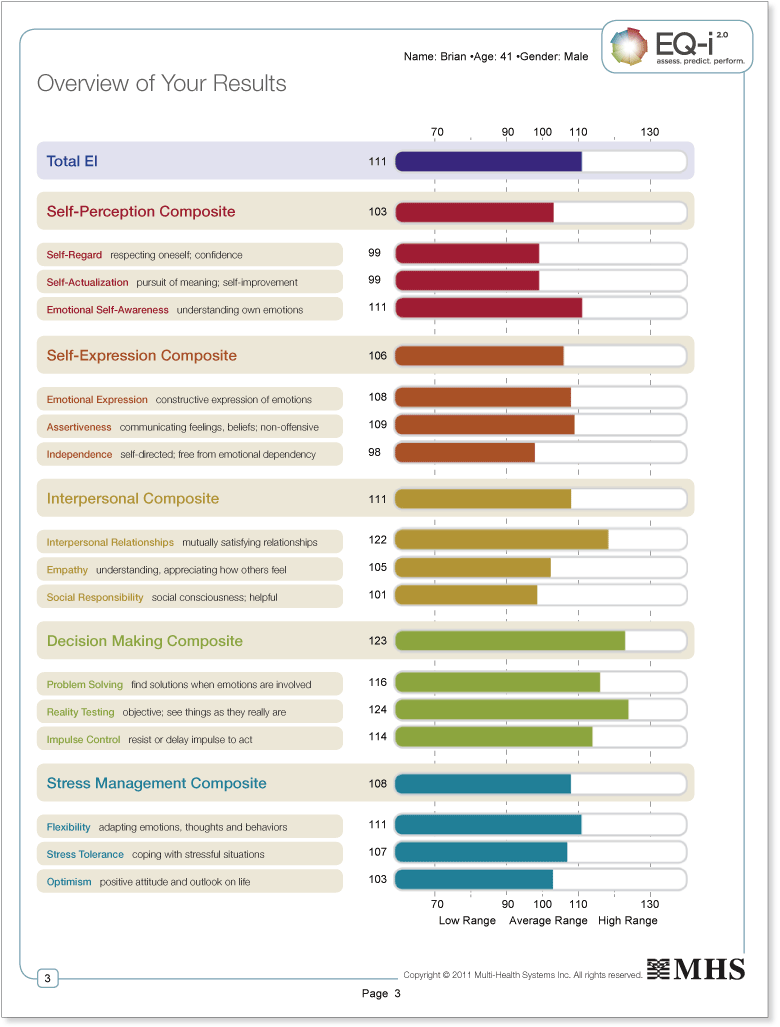Part IV: Using the Results
EQ-i 2.0 Case Studies
Case Study 4
Submitted by: Hile Rutledge
Client Background
Brian is a successful 41-year-old executive newly hired to a consulting firm that works exclusively with the United States Department of Defence. Most of the people now reporting to Brian are Ph.D. researchers 10 to 25 years his senior. Given Brian’s age, his lack of an advanced degree (he has a Bachelor of Arts in History), and his inexperience with advanced research projects, he feels at times stressed by his senior-level position and its demands. Will today be the day that everyone learns how far in over his head he is? This internal query is one that plays on continuous loop within Brian’s head. Seeing the EQ-i 2.0 as an opportunity to sharpen his self-awareness and relationship building skills, Brian eagerly engages in the EI process.
Summary of EQ-i 2.0 Results

To make the EQ-i 2.0 feel less like a report card and more like the spur to a deep, data-driven discussion about self-awareness and self-management, the first step in the feedback process is to define the various elements of the EQ-i 2.0 model by having Brian do a self-assessment as to how often, easily and consistently he engages with each element in his daily life. Low engagement could reflect low skills, but it could also reflect adequate skills in an area seen as unimportant and not often ignored. High engagement could reflect enhanced development and high skills, but it could also indicate over-engagement and a quality or behavior that is over-done or often too intense. Average engagement means the element is used or paid attention to about as much as it is with most people. Average engagement with an EQ element means that there is certainly room for improvement and growth in that area, but there is nothing in average engagement that means that development is required or that this is in any way a liability.
Brian predicted high levels of engagement with Interpersonal Relationship, Reality Testing, Problem Solving and Emotional Self-Awareness; and low engagement with Self-Actualization. All other elements he felt well connected to, but not in a way that would distinguish him from anyone else—so about average. With this self-assessment complete, Brian was now ready to receive and fully understand his EQ-i 2.0 report. Brian’s highest scores—Reality Testing and Interpersonal Relationship and Problem Solving—were not a surprise, but his connection to the EQ-i 2.0 process got a boost from his being able to predict his attachment to these elements.
After noticing these high scores, Brian’s attention was then pulled to some of the lower scores on his report, which did surprise him. Self-Regard and Self-Actualization were among the lowest scores on his report, and while they were (at 99) just under the average, he was surprised by seeing these important elements at the bottom of his line-up. In the discussion that followed, Brian came to realize that in his new environment, in which he was leading so many people a good bit older than he with technical expertise and degrees he did not have, that he was relying on his ability to connect personally and relationship build as a means of management and decision making. And while Brian did this with great frequency and ease, he had a low-boiling fear that he had not pursued enough formal education (in the form of a graduate degree) and/or amassed more research expertise. These fears were evident in his lower Self-Regard and Self-Actualization scores, creating a greater sense of awareness about his otherwise perceived confident and accomplished sense of self.
These realities were adding a new kind of stress to Brian’s professional life, which brought on the biggest surprise of all—a Happiness score that would put him around the bottom third of respondents in Happiness. Long self-described as a happy and funny man, Brian was feeling increasingly disconnected from this personae, and he decided to take steps to correct this disconnect.